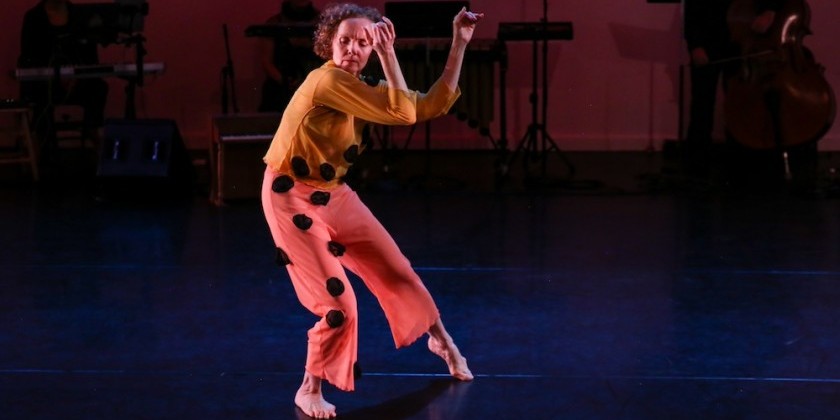IMPRESSIONS: “The Look of Love,” Cheerful Mark Morris Choreography Spawned from Beguiling Burt Bacharach Songs

Choreography: Mark Morris
Music: Burt Bacharach
Lyrics: Hal David
Lyrics from “The Blob”: Mack David
Arrangements: Ethan Iverson
Costume and Production Design: Isaac Mizrahi
Lighting Design: Nicole Pearce
Musicians: Marcy Harriell (lead vocals), Ethan Iverson (piano), Jonathan Finlayson (trumpet), Simón Willson (bass), Vinnie Sperrazza (drums), Clinton Curtis and Blaire Reinhard (background vocals)
Dancers: Mica Bernas, Karlie Budge, Courtney Lopes, Taína Lyons, Matthew McLaughlin, Dallas McMurray, Brandon Randolph, Nicole Sabella, Billy Smith, Noah Vinson
BAM Howard Gilman Opera House, March 20 - 23, 2004
A sunny, 65-minute dance, choreographed by Mark Morris to 14 beguiling Burt Bacharach songs, “The Look of Love” is a music-fueled event, both in its making and performance. While Morris is known for the tight music-movement relationships his concert-dance choreography establishes, here, we feel that partnership more blatantly than ever. Every dance step, gesture, movement phrasing, accent, spatial configuration, and the moods they evoke were clearly spawned in direct response to the Bacharach songs’ music and lyrics (largely by Hal David).
Premiered in Santa Monica, in 2022, “The Look of Love” had its first New York showing at BAM in March, where its performance, by the Mark Morris Dance Group and Music Ensemble, was equally music-driven. Exhilarating, live renditions of Bacharach’s 1960s pop-music hits, robustly arranged by Ethan Iverson, sparked the dancing every step of the way.

Marcy Harriell with the Mark Morris Dance Group. Photo: Julieta Cervantes
From the get-go, we realize music’s in the driver’s seat, as the show opens with the “Alfie” melody emitting, ever-so-quietly, from a solo piano that magically silenced the audience, bringing the enormous opening-night crowd to a communal focus. On its heels, comes the sensational voice of lead singer Marcy Harriell, who chauffeurs us luxuriously through the rest of the evening. Her singing captures a Sixties sound, such that one’s nostalgic associations with the beloved songs are pleasingly triggered. Enriched by imaginative support from two back-up singers and the tight sound of a rhythm section provoked by a swinging trumpet, Harriell’s vocals also generate a stirring, fresh energy that somehow makes it feel “hip” to embrace these old tunes.

While the music is a show in itself, it never overwhelms the ebullient dance activity onstage. Neatly-crafted out of thematic phrases that repeat, vary, and evolve, Morris’s choreography is built on a foundation of lively, modern-dance vocabulary — triplets, side-falls, pedestrian-style running, grapevines, bent-kneed leg lifts, and buoyant jumps — and incorporates actions reflecting ideas put forth by the song lyrics. “Do You Know the Way to San Jose” is animated by exciting repetition of barrel turns, those soaring rotating leaps, here registering as full-body abstractions of the turning motion of a steering wheel. In addition to suggestions of retro pop-dance moves that lend a period flavor to the choreography, Morris makes clever use of literal gestures that, from time to time, sneak into a movement phrase to mirror a song lyric. Arms form into mountain peaks in “What the World Needs Now,” and bodies plop and swish like drops of water in “Raindrops Keep Falling on My Head.” Don’t worry, Morris doesn’t do this to an annoying extent, only sporadically, and to spotlight an important, funny, or delightfully random word.

It all adds up to a quick, rewarding evening of cheerful choreography. Even when the songs speak of heart-rending emotion and romantic break-ups — like those comically “acted out” as mini dance-dramas in “What Do You Get When You Fall in Love” — the choreography maintains an affable air. Heartache is depicted symbolically, often via Morris’s signature style of smart silliness. In “Walk on By,” a lone, hot-pink chair sits center-stage, as dancers walk briskly, purposefully, in different directions, all around it. Ignored, it represents the song’s rejected lover, a sharp expression of the lyric’s tearful sentiments. But after a while one recognizes how ridiculous the chair looks, and then how ridiculous it is for us to be sitting there staring at it while a group of people walk around a stage. The visual humor leavens any sorrowful feelings we might have, just like any hurt heard in the lyrics of Bacharach songs is always buffered by an irresistible bounce in the music.

Despite Morris’s choreographic adherence to the essentials of the songs, his dancers don’t ever appear constrained — in part, perhaps, because of the control they exert over their physical environment, thanks to Isaac Mizrahi’s refreshingly low-tech production design. In front of a plain cyc, deliciously lit by Nicole Pearce in rich reds, yellows, and blues, Mizrahi populates a bare stage with nothing more than bright candy-colored metal folding chairs and seat cushions that the dances intentionally re-arrange and cannily use as props for each different song. Color-coordinated to match the scenic elements, the dancers are costumed (also by Mizrahi) in a happy array of pink, orange, yellow, green, and purple solid-color separates. Each performer wears either tights topped by a loose tunic, or a fitted tank top over loose pants or long skirt. The streamlined look supports the dancers’ movement clarity, while the bold colors of the fabrics mark the movers as strong-willed characters, freely choosing, not forced, to dance in compliance with the music.

This balanced partnership between sights and sounds proves key to “The Look of Love”’s larger message. There’s very little solo dancing within the choreography, no celebration of individuality, and lots of unison movement performed by connected couples or hand-holding groups. While its title may prompt one to search for ways in which the piece shows what love “looks like” vis a vis the emotional content of the songs, that’s not the best route to finding deeper meaning within this merry dance. What love looks like is revealed by Morris, not dramatically, but aesthetically, through his firm linking of music and dancing. Overall, what we consistently sense are joyful connections and feelings of kinship all around. That’s the look of love.












